For
some reason, a bowl of custard isn't seen as an appropriate dessert for
a grown adult – but scorch the top and give it a French name and it's
suddenly all sophisticated
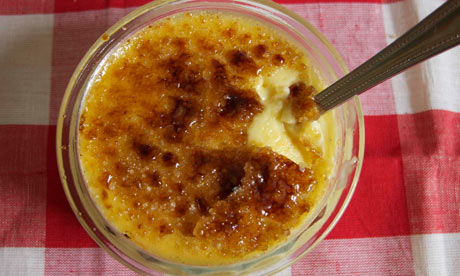
Felicity's perfect creme brulee. Photograph: Felicity Cloake
At one time, between the ages of seven and 12, I believe I was
among the south-east's foremost creme brulee experts. In the 80s and
early 90s, it seemed to be on every dessert
menu – and if it was there, I had to have it. But, even at that age, I
recognised that not all brulees were created equal. The best had a crisp
shell that shattered satisfyingly under my spoon and a rich, smooth
layer of custard beneath with just a whisper of vanilla. Any softness on
the top, or graininess in the custard was not tolerated – although, as a
professional, I always cleaned the dish regardless.
Great was my childish joy when I learned that this dish was in fact British
– the usual story attributes it to Trinity College in Cambridge, which
boasts a dedicated branding iron in the shape of the college crest. But
in fact, Jane Grigson, suspicious of the late date (1860s) given for
this event in Florence White's Good Things in England,
uncovered a trail of recipes leading back to a 17th century manuscript
book. As she notes, "custards made from eggs and cream were a European
commonplace" at the time, so it would be pitifully jingoistic to try and
claim the entire thing for Queen and country – but perhaps we might
take the credit for the inspired addition of the caramel. Which, I think
you'll agree, is what really makes the dish.
Cream and eggs: dairy to dream
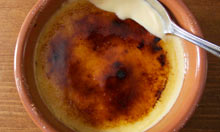
Mrs Raffald recipe creme brulee. Photograph: Felicity Cloake
As the name suggests, dairy of some sort is the key ingredient of creme brulee. Claire Clark, in her book Indulge, and Simon Hopkinson and Lindsey Bareham in The Prawn Cocktail Years use double cream, which makes sense, as this is to be a thick custard. Mary Berry goes for single instead in her Traditional Puddings and Desserts, and Larousse Gastronomique
a mixture of whipping cream and milk. Heston Blumenthal sticks with
just milk. Claire's brulee has the best texture – firm, yet not in the
least rubbery: Mary's is (I hate to say it) slightly too liquid, while
Heston's, perhaps because of the vast number of egg yolks he puts in, is
solid, but rather jellied. Larousse I will deal with later.
In fact, Heston's brulee
is so rich with eggs that I can't face going back for a second
spoonful, an unprecedented occurrence. I think I could probably manage a
good half of Claire's, despite the nine yolks she puts in there – like
Lindsey and Simon's, it's eggy, but not overpoweringly sweet. I prefer
the creamier, lighter flavour of Mary's brulee though, so I decide to
reduce the number of yolks and see whether I can achieve the same
texture without such richness – 3 seems about right for 300ml of cream.
Elizabeth Raffald's 1769 recipe, reproduced in Jane Grigson's English Food,
uses egg whites as well as yolks, beaten separately and added to the
custard along with a spoonful of flour. This gives her custard more
body, but a slightly off-putting paste-like texture and colour.
The sugar
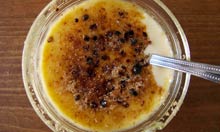
Mary Berry recipe creme brulee. Photograph: Felicity Cloake
Everyone but Larousse uses caster sugar in their custards (they go
for icing sugar, possibly because it dissolves more easily, but it
doesn't seem to make much difference in their case). Mary and Larousse
switch to demerara to top the brulees however, which I like – the
slightly larger grains might not melt to such a smooth, mirror-like
consistency but they stay nicely crunchy and give the top a distinctive
burnt toffee flavour. I need a happy medium between Heston's sickly 60g
and Simon and Lindsey's parsimonious 1 tbsp – after a little
experimentation, 15g for this amount of cream seems to work well.
The flavourings
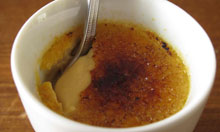
Heston Blumenthal recipe creme brulee. Photograph: Felicity Cloake
Vanilla is, of course, the usual choice here. Heston's three pods
seem excessive - he claims he serves this dish in espresso cups, but
it's so intensely flavoured that a teaspoon would seem a more
appropriate vehicle. Mrs Raffald uses lemon peel and orange flower
water, both of which are rather nice as ideas – but have no place in the
classic brulee. Heston suggests jasmine tea, infused in the hot milk
before it's strained on to the egg yolks – also pleasant, although it
does give the custard a slightly strange brownish tinge.
The method
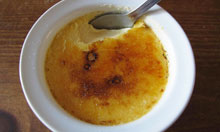
Claire Clark recipe creme brulee. Photograph: Felicity Cloake
Most of the recipes I try – Claire Clark, Heston, Mary Berry –
involve pouring hot milk or cream on to egg yolks and sugar, mixing them
together and then sticking the resulting custard in the oven for half
an hour. I can't believe how easy it is: had I known creme brulee was so
quick, I'd have gorged myself silly long ago. But Simon Hopkinson and
Lindsey Bareham have other ideas: "it seems that creme brulee is made
differently these days," they write disapprovingly. "Once upon a time
one was instructed to make the custard in the traditional way, cooked
very gently in a pan until thick."
Of course, they say, it's
easier to control the cooking time if one takes the easy way out, but
"it does not give the same texture as the stove-top method". For their
recipe, then, I heat the cream with a vanilla pod, leave it to infuse
for a while, then pour it on to the egg yolks and sugar and return the
whole lot to a pan and heat until it thickens "to an almost jelly-like
consistency", rather like in Mrs Raffald's recipe. This is then ready to
chill. Simon and Lindsey describe the results as "voluptuous" but I
think I prefer the light wobbliness of the baked versions.
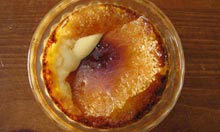
Simon Hopkinson and Lindsey Bareham recipe creme brulee. Photograph: Felicity Cloake
Larousse pique my interest by not bothering to heat the cream before
whisking it into the eggs – according to the instructions, which I
re-read several times in the light of subsequent events, the whole lot
goes into the oven cold. After 30 minutes (no leeway given here) they
come out, the consistency of creme anglaise. Nor do they thicken at all
during chilling. I suspect a step may have been missed out of the
English translation – unless anyone can throw any light on this unusual
method?
Baking and bruleeing
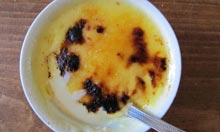
Larousse Gastronomique's recipe creme brulee. Photograph: Felicity Cloake
Of those brulees which make it into the oven, temperatures range from
160C from Mary Berry to 100C for Larousse's culinary disaster. Claire
Clark's 150C, with a cold water bain marie, as opposed to the hot
specified by Mary and Heston, seems to work perfectly. I'm not quite
sure why Mary butters her ramekins either – she seems a practical lady,
so perhaps it makes them easier to clean?
Mary, Larousse and Mrs
Raffald call for the brulees to be grilled, but if you have a blowtorch,
it's much easier to control the heat – and, because it's quicker, you
won't have to wait for the custard to cool again before serving (the
cool creaminess beneath the crunchy topping being surely one of the
glories of this inspired dish.) Simon and Lindsey reckon spraying the
sugar with water helps the caramelisation process, but I find exactly
the opposite. I blame the blowtorch.
Perfect creme brulee
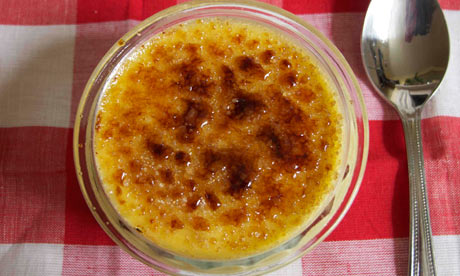
Felicity's perfect creme brulee. Photograph: Felicity Cloake
For some reason, a bowl of custard isn't seen as an appropriate
dessert for a grown adult – but scorch the top and give it a French
name, and it's suddenly all sophisticated. Good served with banana,
nevertheless.
Makes 2
300ml double cream
1 vanilla pod
3 egg yolks
15g caster sugar
1 tbsp demerara sugar
1. Preheat the oven to 150C and put 2 small ovenproof ramekins in a baking tin. Pour the cream into a small, heavy-based pan and slit the vanilla pod in half lengthways. Scrape out the seeds and put the pod and the seeds into the pan with the cream. Bring to the boil over a medium-low heat.
2. Meanwhile put the yolks and caster sugar into a medium-sized heatproof bowl and stir until just combined. When the cream begins to boil, remove the vanilla pod and then pour the cream on to the yolk and sugar mix, stirring constantly to mix.
1 vanilla pod
3 egg yolks
15g caster sugar
1 tbsp demerara sugar
1. Preheat the oven to 150C and put 2 small ovenproof ramekins in a baking tin. Pour the cream into a small, heavy-based pan and slit the vanilla pod in half lengthways. Scrape out the seeds and put the pod and the seeds into the pan with the cream. Bring to the boil over a medium-low heat.
2. Meanwhile put the yolks and caster sugar into a medium-sized heatproof bowl and stir until just combined. When the cream begins to boil, remove the vanilla pod and then pour the cream on to the yolk and sugar mix, stirring constantly to mix.
3. Divide the
mixture between the ramekins and pour cold water into the tin until it
comes two-thirds of the way up the ramekins. Bake for about 40 minutes
until the custard is set – it should only wobble faintly when shaken.
Cool and then chill until cold.
4. Scatter the tops of the cold brulees with demerara sugar, and use a blowtorch or hot grill to caramelise the tops – if using a grill, you may need to put them back in the fridge for half an hour before serving to cool down again.
4. Scatter the tops of the cold brulees with demerara sugar, and use a blowtorch or hot grill to caramelise the tops – if using a grill, you may need to put them back in the fridge for half an hour before serving to cool down again.
Creme brulee or burnt cream – where do you stand on its origins? Would you claim it for Spain
instead – or even, as Julia Child insists, Creole Louisiana? Should
they be strongly flavoured or sumptuously plain, and which other classic
desserts are surprisingly easy to make?

Aucun commentaire:
Enregistrer un commentaire